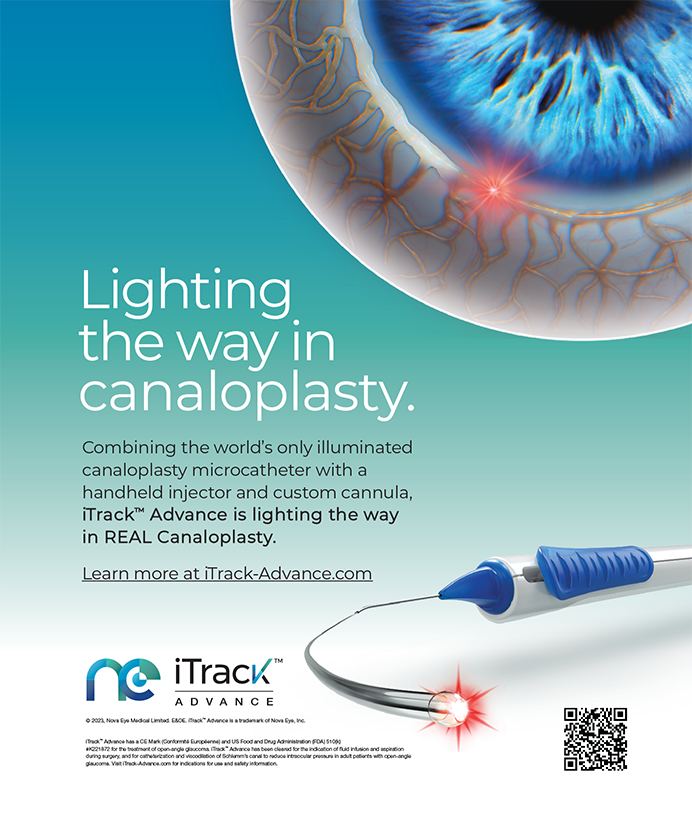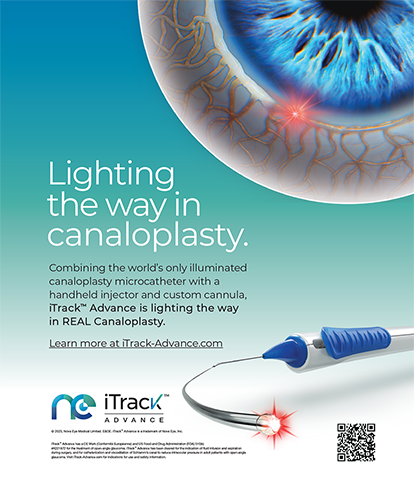An intact capsulorhexis is a vital component in any cataract surgery. In complex cases, the capsulorhexis is even more critical and, sometimes, it can determine either the success or failure of the planned case. There are several instances in which the capsulorhexis can be particularly challenging. These technical challenges tend to occur most commonly in cases in which an intact capsulorhexis is so vitally important. In this article, I review various principles of performing a capsulorhexis and discuss some of the procedure's related challenges and techniques.
ACCESSING THE CATARACT
As surgeons, when we create a capsulorhexis, our goal is to create a continuous opening in the anterior capsular membrane. This opening allows adequate access to the cataractous lens material while maintaining adequate membrane structure for the safe implantation and long-term centered fixation of an IOL and, perhaps, a capsular tension ring and/or iris prosthetic device.
THE HYPERMATURE OR INTUMESCENT LENS
In cases in which the cataract has become either hypermature or intumescent, the cortical material has broken down, and, in the process, created an osmotic flow gradient, bringing additional fluid into the capsular bag. This situation causes a commensurate increase in the intracapsular hydrostatic pressure. Sudden release of this pressure gradient into the anterior chamber with the initiation of the capsular opening can create a forceful and rapid efflux of fluid, potentially causing a complete splitting of the capsular bag (Argentinean blue flag syndrome). This incident obviously markedly endangers the safe completion of the case and could lead to a dislocation of the nucleus into the posterior segment.
There are few maneuvers that will prevent this occurrence. First, staining the capsule with either trypan blue or indocyanine green will aid in visualization. Before attempting to open the anterior capsule, ensure that the anterior chamber is overpressurized, such that the anterior chamber pressure exceeds the endolenticular pressure. Typically, this step will require the generous use of an ophthalmic viscosurgical device (OVD) that has good cohesive properties. Under the operative microscope, the surgeon should see (at least) a slight flattening of the convexity of the anterior capsular surface. Next, a 25-gauge short needle (5/8") is placed on a 3-mL syringe, filled only halfway with balanced salt solution. The needle's tip is placed through the paracentesis, taking care not to allow any OVD to escape. With the needle's tip oriented with the bevel down, the needle pierces the capsular bag axially, and the syringe's plunger is immediately withdrawn to evacuate liquid contents from the confines of the bag (Figure 1). This process will effectively decompress the bag and neutralize the pressure gradient between the anterior chamber and intralenticular space. The remainder of the capsulorhexis can now be safely completed with the surgeon's preferred technique.
CAPSULORHEXIS IN THE PRESENCE OF ZONULAR COMPROMISE
Routine capsulorhexis requires a balance between the centripetal forces applied to the anterior capsule by the surgeon against the centrifugal countertraction force from the zonular apparatus and the force of the lens material against the forniceal equator of the bag. In cases of zonular compromise, the "normal" balance of forces does not exist, and creating a continuous curvilinear capsulorhexis (CCC) becomes challenging. In some cases, the zonular compromise is not suspected until the initiation of the anterior capsular tear, in which a "pincushion" effect is noted as an attempt to puncture the anterior capsule is initiated and the capsule indents significantly before the needle will penetrate. This sign indicates diffuse zonular laxity and should alert the surgeon that he must be extremely attentive at this point. In cases where the zonular abnormality is well known, and, perhaps, the lens is subluxated, we need to determine where the CCC should be centered. There may be a temptation to make the CCC centered on the pupil center or the geometric center of the cornea, as we do in a routine case. This temptation should be avoided. If the crystalline lens is decentered, we must actively concentrate on keeping the CCC centered on the axis of the cataractous lens (Figure 2). An overly eccentric CCC can sometimes make capsular tension ring placement difficult, because during insertion, the ring tends to migrate out of the bag if the peripheral portion of the CCC is too near the equator.
Often, in cases of severe zonular compromise, the crystalline lens must be stabilized by either supporting the already torn portion of the capsulorhexis' margin with a hook similar to the Kuglen hook (Katena Products, Inc., Denville, NJ), flexible iris, or capsule retractor. Alternatively, one can stabilize the capsule with a forceps. Placement of an Ahmed segment (Morcher GmbH, Stuttgart, Germany) focally can stabilize the bag for completion of the capsulorhexis as well, provided that the portion that has already been opened is of sufficient size to place the segment without excessive manipulation. Although it has not yet been reported, focal placement of an Assia Anchor (Hanita Lenses, Kibbutz Hanita, Israel) could theoretically be used to stabilize the lens-bag complex to complete the capsulorhexis.
Regardless of the stabilization method selected, one should not attempt to recenter the lens-bag complex at least until the capsulorhexis has been completed.
With regard to CCC size, a larger capsulorhexis will facilitate the lens' removal from the bag, yet, if the CCC does not overlap the margin of the IOL, the surgeon should be aware that the lens will sit slightly anterior relative to the zonular plane, thus altering the IOL's refractive effectiveness. Accordingly, an IOL with less power may be appropriate compared to what might have been selected for cases in which the CCC margin covers the IOL edge.
CAPSULAR PLAQUE
In some cases, an anterior capsular plaque may exist along the planned path of the continuous tear capsulorhexis. In such cases, three effective techniques will allow the completion of a continuous capsulotomy. First, if the plaque is small in size, the planned path of the CCC can be altered to come either central or peripheral to the location of the plaque. If the plaque is too large to circumnavigate, the portion of the pathway that goes through the path of the intended capsulotomy can be extended with microscissors. If this technique is selected, it is critical that the surgeon begin the scissors portion of the cut slightly outside the point at which the continuous tear meets the plaque. This method will ensure maintained structural integrity of the capsular opening. In contradistinction, if the surgeon were to initiate the scissors cut just inside the point at which the tear meets the plaque, the weakest point of the capsular opening will be located exactly where the tear meets the plaque. In such an instance, further manipulations or expansion of the capsular bag may be much more likely to result in a peripheral, radial extension of the capsular opening with compromised integrity.
Once the plaque has been completely cut, the continuous tear can be completed.
Use of the Fugo blade (MediSURG Research & Management Corporation, Norristown, PA) presents another option (see The Pros and Cons of the Fugo Plasma Blade on page 88).
ERRANT PERIPHERAL DEVIATION OF A CAPSULORHEXIS
If a capsulorhexis begins to deviate peripheral to its intended path, extreme attentiveness is the first appropriate tactic. Any forces on the capsule should be ceased, and stabilize the anterior segment by adequately deepening and pressurizing the anterior chamber. If the origin of the peripheral movement can be identified, it should clearly be reversed. For example, if the anterior chamber is too shallow, it should be deepened; if the view of the capsule was inadequate, then capsular dyes should be applied. Ideally, the tear should be redirected by folding over the leading edge of the capsule to better control the tear. Although some surgeons have reported pulling the capsule in the opposite direction of the tear, which presumably should bring the tear centrally, I have not tried this maneuver.
If the tear has already extended to the zonules, surgeons should avoid further manipulations in that area. It is probably wiser to start the tear in the opposite direction and complete from the opposite rotation. Some surgeons advocate one or more additional radial breaks in the CCC in such cases to reduce the direct forces on the one break point. Surgeons should perform hydrodissection with extreme caution, and, if attempted, remove some of the OVD moved to shallow the anterior chamber before the hydrodissection wave so that if the pressure within the bag increases, the lens will be more likely to come forward, rather than the posterior capsule splitting posteriorly.
WHEN THE CAPSULORHEXIS IS TOO SMALL
If the CCC is too small, the surgeon can carefully enlarge it by making a small tangential incision in the CCC and peeling an additional small amount off the margin in a spiral. Surgeons can repeat this maneuver as needed, remembering that although it is a bit challenging to enlarge the opening, reducing its aperture is impossible. I typically prefer to wait until after posterior chamber IOL placement to enlarge a CCC.
SUMMARY
The capsulorhexis remains among the most crucial step in the complex cataract case, both for safe removal of the lens material and for ultimate fixation of the implanted lens. The components of a complex capsulorhexis can be highly variable, yet, with meticulous attention to technique, most of these problems can be overcome, even in the most difficult cases. The surgeon should always keep in mind the balance of all hydrostatic and mechanical forces on the capsular bag, how these forces are unique to a given case. and how they can be manipulated either by altering the hydrostatic pressures or the mechanical stresses applied to the capsule to achieve an intact capsulorhexis with the greatest degree of safety. Prudent use of an appropriately chosen OVD and/or capsule-expanding or fixating device can aid the surgeon in this endeavor.
Michael E. Snyder, MD, is in private practice at the Cincinnati Eye Institute and is Voluntary Assistant Professor of Ophthalmology at the University of Cincinnati. He acknowledged no financial interest in the products or companies mentioned herein. Dr. Snyder may be reached at (513) 984-5133; msnyder@cincinnatieye.com.


